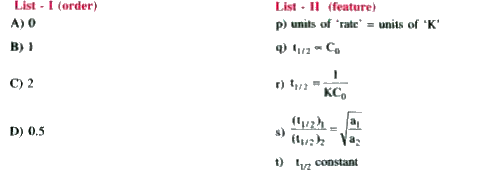A reaction A2+B2→2AB occurs by the following mechanism:
A2⇔A+A…………(fast)
A+B2→AB+B……….(slow)
A+B→AB…………..(fast) Its order would be:Solution in Telugu
44257
1
zero
2
The correct Answer is:A
r=K1(A)[B2],r=K1(Kc)12.[A2]12[B2]1[r]=K.[A2]12[B2]
order =12+1=32,KC=[A]2[A2],[A]=(Kc)12.[A2]12
Topper's Solved these Questions
- BOOK - AAKASH SERIESCHAPTER - CHEMICAL KINETICSEXERCISE - LEVEL-II(LECTURE SHEET EXERCISE-II LINKED COMPREHENSION TYPE QUESTIONS)9videos
CHEMICAL KINETICS
- BOOK - AAKASH SERIESCHAPTER - CHEMICAL KINETICSEXERCISE - LEVEL-II(LECTURE SHEET EXERCISE-III MATCH THE FOLLOWING QUESTIONS)3videos
CHEMICAL KINETICS
- BOOK - AAKASH SERIESCHAPTER - CHEMICAL KINETICSEXERCISE - LEVEL-1 (EXERCISE -II ORDER, MOLECULARITY, HALF LIFE:)34videos
CHEMICAL KINETICS
- BOOK - AAKASH SERIESCHAPTER - CHEMICAL KINETCSEXERCISE - EXERCISE - 3.245videos
CHEMICAL KINETCS
- BOOK - AAKASH SERIESCHAPTER - CHEMICAL THERMODYNAMICSEXERCISE - Additional Practice Exercise54videos
CHEMICAL THERMODYNAMICS
Similar Questions
A certain endothermic reaction: A→ Product, ΔH=+ve proceeds ina sequence of three elementary steps with the rate constant K1,K2 and K3 and each one having energy of activation E1,E2 and E3 respectively at 25∘C. The observed rate constannt for the reaction is equal to K3√K1K2.
A1,A2 and A3 are Arrhenius parameters respectively.
The observed energy of activation for the reaction is03:30View SolutionMatch the following columns
 01:21View Solution
01:21View SolutionSucrose decompose in acid solution into glucose and fructose according to the first order rate law, with t12=3.00 hours. What fraction of sample of sucrose remains after 8 hours ?
03:04View SolutionDiscuss on the kinetic spontaneity of a chemical reaction. Is a slow reaction spontaneous? Why?
02:20View SolutionWhich among the following is not an exact differential?
01:41View SolutionA hypothetical reaction A_(2) + B_(2) rarr 2AB follows the mechanism as given below: A_(2) hArr A+A ("fast") A+B_(2) rarr AB+B (slow) A+B rarr AB (fast) The order of the overall reaction is
02:09View SolutionA reaction A_(2)+B_(2)rarr 2AB occurs by the following mechanism: Ararr A+A … (slow) A+B_(2)rarr AB+B … (fast) A+Brarr AB … (fast) Its order would be
01:41View SolutionA reaction A_(2)+B rarr products, involves the following mechanism : A_(2) hArr 2A ("Fast")" " ( A being the intermediate ) A+B underset(k_(2))rarr products (slow). The rate law consistant to this mechanism is :
01:59View SolutionA_(2)+B_(2)to2AB , R.O.R.= k[A_(2)]^(a)[B_(2)]^(b) {:(,"Initial"[A_(2)],"Initial"[B_(2)],R.O.R.(r) Ms^(-1)),(,0.2,0.2,0.04),(,0.1,0.4,0.04),(,0.2,0.4,0.08):} Order of reaction with respect to A_( 2) and B_(2) are respectively :
03:30View SolutionThe reaction 2A+Bto product follow the mechanism :- 2AhArrA_(2)("fast") A_(2)+BtoP(slow) The order of the reaction is
02:43View SolutionIn hypothetical reaction, A2+B2→2AB, follows the follows the mechnism as given below :
A2⇔A+A(fast reaction)A+B2→AB+B(slow reaction)A+B→AB(fast reaction)
Give the rate law and order of reaction03:30View SolutionThe order of the reaction occuring by following mechanism should be (i) A_(2) to A + A (fast ) " " (ii) A+ B_(2) to AB + B (Slow ) (iii) A + B to (Fast)
View Solutionthe value of the determinant
∣∣ ∣ ∣ ∣ ∣∣(a1−b1)2(a1−b2)2(a1−b3)2(a1−b4)2(a2−b1)2(a2−b2)2(a2−b3)2(a3−b4)2(a3−b1)2(a3−b2)2(a3−b3)2(a3−b4)2(a4−b1)2(a4−b2)2(a4−b3)2(a4−b4)2∣∣ ∣ ∣ ∣ ∣∣ is08:37View SolutionA hypothetical reaction, A_(2)+B_(2)to2 AB, follows the mechanism as given below : A_(2)iff A+A" "("Fast") A+B_(2)to AB+B" "("Slow") A+BtoAB" "("Fast") The overall order of reaction is
02:55View SolutionFor the reaction 2A3⇔3B2
Mechanism
A3⇔B2+I*, kc (fast)
A3+I*→2B2, k (slow)
For the net reaction, correct statement is :04:28View Solution

